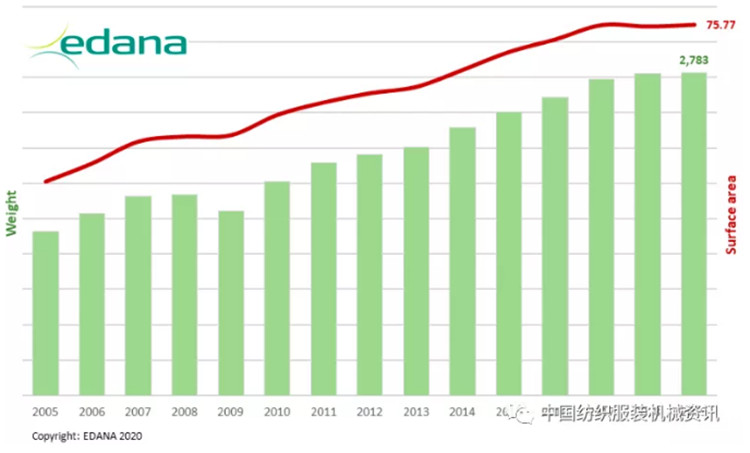As A Result Of The Recent Economic Conditions And, In Particular, The Downturn In Several End-Use Sectors, Figures For Greater Europe (Western, Central And Eastern Europe, Turkey, Belarus, Ukraine And Russia) Show That The Overall Production Of Nonwovens Has Been Flat In Both Weight (+0.3%) And In Surface Area (+0.5%) Compared With 2018.
According To Figures Collected And Compiled By The EDANA Secretariat, Production Of Nonwovens In Europe Reached 2,782,917 Tonnes. This Compares With 2,774,194 Tonnes In 2018 When The Annual Growth Was 1.5%. Despite These Two Low Growth Years, European Production Recorded An Average Growth Rate Of 4.4% Over The Last Decade.

Greater European Nonwovens Production Reached 4.4% Annual Average Growth Over The Last Decade, According To EDANA’S 2019 Statistics
EDANA Says A More In-Depth Analysis Will Be Necessary To Draw A Definitive Conclusion, As Diverging Trends Have Been Observed In Different European Countries And Between The Various Production Processes And Market Segments Of Nonwovens.
Jacques Prigneaux, EDANA’S Market Analysis And Economic Affairs Director, Says: “In Terms Of Apparent Growth Rates, Airlaid Nonwovens Have Been In Line With The Long-Term Trend This Year, But It Is Actually The Hydroentanglement Process That Has Recorded The Highest Growth Rate At Slightly More Than 5.5%. However, Other Bonding Processes Within The Drylaid Technologies (Thermally, Air-Through, Chemically Bonded And Needlepunched), As Well As Wetlaid Nonwovens Witnessed Either Flat Or Negative Growth Rates In 2019. Spunmelt Nonwovens Production, Compared To Its Performance Of 2018, Recorded A Growth Of 0.6%.”
The Main End-Use For Nonwovens Remains The Hygiene Market With A 29% Share Of Deliveries, Amounting To 792,620 Tonnes, A Growth Of 1.5% In 2019. The Most Significant Increases In Percentage In 2019 Were In Table Linen (+12.3%) And Electronic Materials (+6.8%). In Contrast, Several Important Sectors In Terms Of Volumes Sold Showed Limited (And Sometimes Negative) Growth Rates: Eg Personal Care Wipes (+1.6%), Building/Roofing (-0.3%), Civil Engineering (-1.5%) And Automotive Interiors (-2.5%). Additionally, Major Declines Were Noticed In Medical Applications, Garments, Interlinings And Wall Coverings.
“Without The Help Of Participating Companies,” Prigneaux Notes, “These Figures Couldn’T Be Compiled, And We Would Like To Thank Them Again For Their Efforts In Sending Their Input To Us, Especially During The Tumultuous Period Of The First Quarter Of 2020.”
“Thanks To A Convergence Of Efforts Of The Participating Companies, To An Improved ISO Definition Of Nonwovens And To The Continuous Monitoring Of EDANA Staff, These Statistics Are More And More Relevant For Planning And Benchmarking Purposes Within Member Companies,” Prigneaux Adds.
The Full Report Titled 2019 European Nonwovens Production And Deliveries Is Available To EDANA Members, Who Will Soon Receive Their Complimentary Copy. The 2019 Statistics Will Be Also Available Through The EDANA Statistics App And At Http://Edanastatapp.Org.
“As The World Continues To Discover The Important Role Of Nonwovens In Protecting Healthcare Staff And Patients Through Medical Devices And Personal Protective Equipment, Such As Surgical Masks, Respirators, Gowns, Drapes And Coveralls During The Covid-19 Pandemic, Our Ongoing Commitment Is To Work With Partner Associations Throughout The World And To Harmonise Nonwoven Production And Sales Statistics As Well As Our Positions On Trade Classification Rules,” Says Wiertz. “This, Together With The Now Improved ISO Nonwovens Definition, Should Give The Whole Industry The Visibility It Deserves.”
EDANA ISSUES STATEMENT ON CORONAVIRUS
Earlier This Month, EDANA Published A Statement On The Measures It Is Taking To Support The Industry Amid The Coronavirus Crisis.
In These Unprecedented Times, EDANA Says That The Nonwovens And Related Industries Are “Proving An Essential Partner In The Fight Against The Coronavirus Pandemic”.
Issuing A Message To The European Commission, Wiertz Says: “EDANA Has Been Working Closely With The Services Of The European Commission To Find Solutions To The Continued Provision Of The Essential Medical And Protective Equipment And To Any Bottleneck In The Supply Chain.
“The Availability Of Disposable Hygiene And Medical Products To The General Public, Hospitals And Care Homes, Is An Essential Element In The Fight Against Covid-19.
“We Have Sent A Letter To The European Commission, Requesting Its Support In Working With Member States To Ensure That All Production Facilities Where These Products Are Manufactured Are Kept Fully Operational In The Interest Of Public Health.”
Post time: May-29-2020
